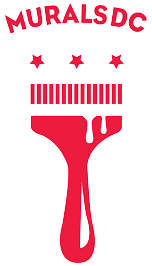While countless cities are battling illegal graffiti, a growing number are looking to the collaboration of artists, local governments, property owners, and community members to create murals to enliven heavily tagged areas and promote community involvement. Graffiti abatement programs have witnessed the way murals have stemmed illegal tagging. MuralsDC joins a number of efforts throughout the country that engage their neighborhoods with the means to be expressive artistically and legally. Here is a sampling of initiatives across the nation:
- Mural Arts: Philadelphia, PA. Philadelphia’s Mural Arts Program is a multi-faceted program which has commissioned the creation of over 3,000 murals since it began in 1984. The Mural Arts Program includes youth education as well as restorative justice programs.
- StreetSmARTS: San Francisco, CA has a strong muralist history, so it has only been a manner of time for the Bay to embrace this tradition as a means to enhance its communities and deter tagging. A collaboration between the San Francisco Arts Commission and the Department of Public Works, StreetSmARTS was created in 2009.
- City Arts: Baltimore, MD. “Mayor Stephanie Rawlings-Blake and the Baltimore Office of Promotion & The Arts have announced CityPaint 2012: Baltimore Mural Program. This initiative will decorate Baltimore City with numerous murals this year. As part of the Cleaner, Greener Baltimore program, the city is partnering with neighborhood groups, community organizations, artists and corporations for CityPaint 2012.”
- Artmakers, Inc: New York, NY. “Established in 1983, Artmakers Inc. is an artist-run, politically oriented community mural organization that creates high quality public art relevant to the lives, work and concerns of people in their neighborhoods. In its 25 years, Artmakers has created over 40 murals in collaboration with block associations, health care and mental health facilities, public schools, community gardens, LDCs, homeless shelters, day care centers and other arts organizations.”
- Living Walls Conference: Atlanta, GA. “Living Walls is an annual conference on street art and urbanism that began in August 2010 in the city of Atlanta. Living Walls Concepts, a year-round conduit to the annual conference, also hosts lectures, exhibitions, and workshops.”
- Vista in Bloom: Vista, CA. “Vista in Bloom! The City of Vista Public Arts Commission has sponsored three phases of a city-wide utility box beautification project called ‘Vista in Bloom’. The project is one of community pride that involves the painting of designated utility boxes in the downtown Vista area.”
- SPARC: Los Angeles, CA. “Art, Education, and Social Justice. SPARC is a community cultural center that produces, preserves, and presents public art as a vehicle to promote civic dialogue, foster cross-cultural understanding, and address critical social issues. Creating Sites of Public Memory since 1976.”
- Wall Therapy: Rochester, NY. “Essentially, what we are doing is a community-level intervention in the form of mural art in the public space. The walls are our vehicle for inspiring and rehabilitating our community. We are intervening visually to address a fundamental collective need of our citizenry, the need for inspiration. In addition and quite literally, the walls on which our ‘therapists’ will paint are being resurfaced and rehabilitated…given new life and energy.”
- Inside Out: “INSIDE OUT is a large-scale participatory art project that transforms messages of personal identity into pieces of artistic work. Everyone is challenged to use black and white photographic portraits to discover, reveal and share the untold stories and images of people around the world. These digitally uploaded images will be made into posters and sent back to the project’s co-creators for them to exhibit in their own communities.”
- Community Arts: Catch-all blog keeping tabs on initiatives all over the country. “This blog reports on participatory and community based visual arts projects. We will examine how projects transform the places we live, change and save lives, transcend differences, challenge stereotypes and build a more egalitarian and democratic society.”

